Digital Thermometer Using PIC16F688
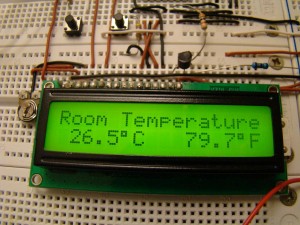 This Digital Thermometer is designed to the temperature of the room and it will display its equivalent value on a LCD screen in both Fahrenheit and Celsius scales. PIC16F688 microchip is used as the main controller in this electronics project. In this Digital Thermometer PIC16F688 microchip reads the temperature value from a DS1820which is a 3-pin digital temperature sensor (from Maxim Semiconductors). This DS1820 digital temperature sensor is designed for measuring the temperature measuring from -55 to 125 °C in 0.5°C increment. Our room temperature never goes that much far but the firmware designed for this PIC is able to measure and displays the entire temperature range from DS1820.We have tested this project on different room temperature. We also tested this electronics project from -4.5°C (in our freezer) and also we tested the temperature of our soldering iron of about 105.5 °C.
This Digital Thermometer is designed to the temperature of the room and it will display its equivalent value on a LCD screen in both Fahrenheit and Celsius scales. PIC16F688 microchip is used as the main controller in this electronics project. In this Digital Thermometer PIC16F688 microchip reads the temperature value from a DS1820which is a 3-pin digital temperature sensor (from Maxim Semiconductors). This DS1820 digital temperature sensor is designed for measuring the temperature measuring from -55 to 125 °C in 0.5°C increment. Our room temperature never goes that much far but the firmware designed for this PIC is able to measure and displays the entire temperature range from DS1820.We have tested this project on different room temperature. We also tested this electronics project from -4.5°C (in our freezer) and also we tested the temperature of our soldering iron of about 105.5 °C.
If you also want to test this electronics project then don’t keep whole components in the freeze, LCD may not work properly at freeze temperature so just keep the temperature sensor inside the freeze and then connect with three wires in the project.
Circuit Diagram and Working Function
In this electronics project PIC16F688 reads the value from RA5 port of DS1820 and then the computed readings is sent to the LCD through RC0, RC1, RC2, RC3 ports. This means that LCD gets data from PIC in 4-bit order mode. The RS (Register Select) signals are provided through ports RC4 to the LCD and similarly, E (Enable) signals for LCD are transferred through RC5 ports. The Read/Write ports are grounded since there is no necessary to read data from LCD in this electronics projects. And contrast is maintained in LCD through the 10K potentiometer as shown in the Circuit below.
There are two switches for the user inputs. The first one is for the reset of whole system and reinitialize the LCD and the second one is for the LCD light mode. LCD back light turns OFF or ON.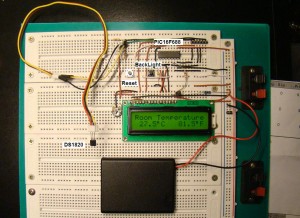
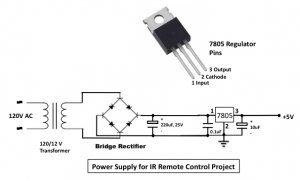
Circuit Diagram For Digita Thermometer
Source Code:
The coding was done in micro C Compiler with the inbuilt library files of DS1820.
/*
Digital Room Thermometer using PIC16F688
April 05, 2012
*/
// LCD module connections
sbit LCD_RS at RC4_bit;
sbit LCD_EN at RC5_bit;
sbit LCD_D4 at RC0_bit;
sbit LCD_D5 at RC1_bit;
sbit LCD_D6 at RC2_bit;
sbit LCD_D7 at RC3_bit;
sbit LCD_RS_Direction at TRISC4_bit;
sbit LCD_EN_Direction at TRISC5_bit;
sbit LCD_D4_Direction at TRISC0_bit;
sbit LCD_D5_Direction at TRISC1_bit;
sbit LCD_D6_Direction at TRISC2_bit;
sbit LCD_D7_Direction at TRISC3_bit;
// End LCD module connections// Back Light Switch connected to RA1
sbit BackLight at RA1_bit;
// Define Messages
char message0[] = “LCD Initialized”;
char message1[] = “Room Temperature”;// String array to store temperature value to display
char *tempC = “000.0”;
char *tempF = “000.0”;// Variables to store temperature register values
unsigned int temp_whole, temp_fraction, temp_value;
signed int tempinF, tempinC;
unsigned short C_Neg=0, F_Neg=0, TempH, TempL;void Display_Temperature() {
// convert Temp to characters
if (!C_Neg) {
if (tempinC/1000)
// 48 is the decimal character code value for displaying 0 on LCD
tempC[0] = tempinC/1000 + 48;
else tempC[0] = ‘ ‘;
}
tempC[1] = (tempinC/100)%10 + 48; // Extract tens digit
tempC[2] = (tempinC/10)%10 + 48; // Extract ones digit// convert temp_fraction to characters
tempC[4] = tempinC%10 + 48; // Extract tens digit// print temperature on LCD
Lcd_Out(2, 1, tempC);if (!F_Neg) {
if (tempinF/1000)
tempF[0] = tempinF/1000 + 48;
else tempF[0] = ‘ ‘;
}tempF[1] = (tempinF/100)%10 + 48; // Extract tens digit
tempF[2] = (tempinF/10)%10 + 48;
tempF[4] = tempinF%10 + 48;
// print temperature on LCD
Lcd_Out(2, 10, tempF);
}// ISR for LCD Backlight
void interrupt(void){
if (INTCON.INTF == 1) // Check if INTF flag is set
{
BackLight =~BackLight; // Toggle Backlight
Delay_ms(300) ;
INTCON.INTF = 0; // Clear interrupt flag before exiting ISR
}
}void main() {
TRISC = 0x00 ;
TRISA = 0b00001100; // RA2, RA3 Inputs, Rest O/P’s
ANSEL = 0b00000000;
PORTA = 0b00000000; // Start with Everything Low
PORTC = 0b00000000; // Start with Everything Low
CMCON0 = 0b00000111;
Lcd_Init(); // Initialize LCD
Lcd_Cmd(_LCD_CLEAR); // CLEAR display
Lcd_Cmd(_LCD_CURSOR_OFF); // Cursor off
BackLight = 1;
Lcd_Out(1,1,message0);
Delay_ms(1000);
Lcd_Out(1,1,message1); // Write message1 in 1st row
// Print degree character
Lcd_Chr(2,6,223);
Lcd_Chr(2,15,223);
// different LCD displays have different char code for degree
// if you see greek alpha letter try typing 178 instead of 223Lcd_Chr(2,7,’C’);
Lcd_Chr(2,16,’F’);// Interrupt Setup
OPTION_REG = 0x00; // Clear INTEDG, External Interrupt on falling edge
INTCON.INTF = 0; // Clear interrupt flag prior to enable
INTCON.INTE = 1; // enable INT interrupt
INTCON.GIE = 1; // enable Global interruptsdo {
//— perform temperature reading
Ow_Reset(&PORTA, 5); // Onewire reset signal
Ow_Write(&PORTA, 5, 0xCC); // Issue command SKIP_ROM
Ow_Write(&PORTA, 5, 0x44); // Issue command CONVERT_T
INTCON.GIE = 1; // 1-wire library disables interrpts
Delay_ms(600);
Ow_Reset(&PORTA, 5);
Ow_Write(&PORTA, 5, 0xCC); // Issue command SKIP_ROM
Ow_Write(&PORTA, 5, 0xBE); // Issue command READ_SCRATCHPAD// Read Byte 0 from Scratchpad
TempL = Ow_Read(&PORTA, 5);
// Then read Byte 1 from Scratchpad
TempH = Ow_Read(&PORTA, 5);
temp_value = (TempH << 8)+ TempL ; // check if temperature is negative if (temp_value & 0x8000) { C_Neg = 1; tempC[0] = ‘-‘; // Negative temp values are stored in 2’s complement form temp_value = ~temp_value + 1; } else C_Neg = 0; // Get temp_whole by dividing by 2 temp_whole = temp_value >> 1 ;
if (temp_value & 0x0001){ // LSB is 0.5C
temp_fraction = 5;
}
else temp_fraction = 0;
tempinC = temp_whole*10+temp_fraction;if(C_Neg) {
tempinF = 320-9*tempinC/5;
if (tempinF < 0) {
F_Neg = 1;
tempF[0] = ‘-‘;
tempinF = abs(tempinF);
}
else F_Neg = 0;
}
else tempinF = 9*tempinC/5 + 320;
//— Format and display result on Lcd
Display_Temperature();} while(1);
}
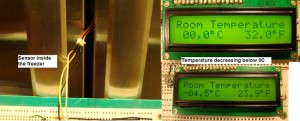
Freeze Temperature
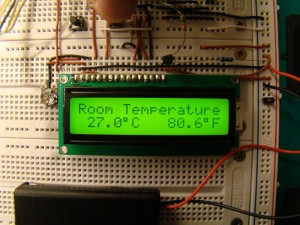
Back Light ON
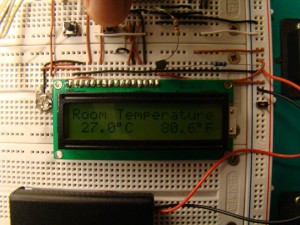
Back Light OFF









Comments (3)